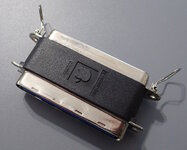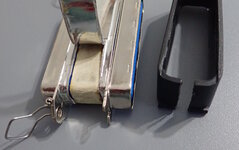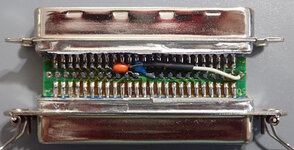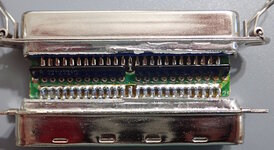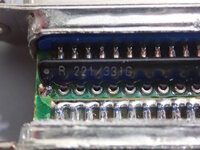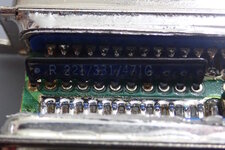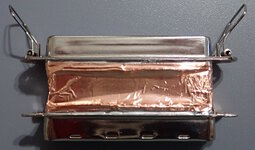David Cook
Well-known member
The Macintosh IIfx has a special black SCSI terminator compared to the standard passive terminators. Unfortunately, the black terminators list for upwards of $200 on eBay. Furthermore, there is confusion and myths surrounding whether they are necessary and how they actually differ electronically from standard passive terminators.
Fortunately, Apple provided the exact circuitry and differences in Macintosh "Technical Note DV 15 - SCSI Termination" (attached).
There are three differences:
1. The addition of a 2.2 uF capacitor connected between terminator power and ground
2. The addition of a 0.01 uF capacitor connected between terminator power and ground
3. The reduction in pullup resistance only on the REQ pin, dropping from 220 ohms to 150 ohms. Note the other pins remain at 220 ohms.
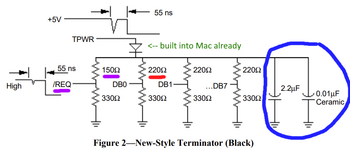
The purpose of these changes is to prevent the REQ pin from accidentally dropping low when a bunch of other SCSI pins are quickly pulled down intentionally, as might happen at high speed. The capacitors provide a little bit of local power storage to supply during rapid changes, and the lower resistance on the REQ pullup makes it a little harder to pull down.
Many people have already pointed out that an active terminator will do an even better job, as it has even lower resistance pullup resistors, a voltage regulator, and capacitors. Now that you know what changes are in the IIfx terminator, you can be confident that the advice to use an active terminator is correct.
However, maybe SCSI voodoo has a grip on you, and you're sure that a black IIfx terminator would fix the issue. Well friend, you can make your own by modifying a successor passive terminator released by Apple. Buy a 590-0695-A on eBay for $12 plus shipping.
Cut open the terminator casing using a Dremel with cutoff wheel or your choice of tools. For example, slit the side of the gray rubber to pop it off. Then cut the metal shielding foil and peel it back. Undo the tape that holds the tan plastic inserts.
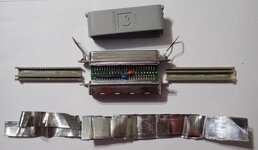
The first surprise is that this Apple passive terminator already includes the correct capacitors! So, this is an upgrade from the standard passive terminator.
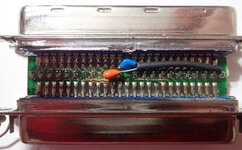
Flip it over to notice the interesting resistor packs have dual 220 ohm / 330 ohm resistors. I guess there was enough demand for SCSI terminators to manufacture special parts like this.
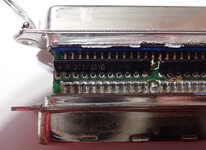
Flip the terminator back to the side with the capacitors. All you need to do is solder a 470 ohm resistor between the center pin (TERM power) and pin 48 (REQ). A little heatshrink tubing or kapton tape prevents a short.
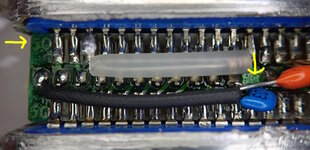
A 470 ohm resistor in parallel with a 220 ohm resistor (already installed) = ~150 ohms.
Reassemble the terminator. I had to nibble a bit of the tan plastic insert away to compensate for the space taken up by the resistor and heatshrink tubing. For the metal wrapping, you can resolder the peeled shielding or get a roll of grounding tape (aka EMI shielding tape, aka double-sided conductive copper foil tape) from Amazon.
Or, maybe just buy an active terminator like Apple 590-0772.
If this has helped you, all I ask is that you ping me if you run across any 16 MB IIfx memory SIMMs for sale. My poor IIfx currently sits at 20 MB. : )
- David
Fortunately, Apple provided the exact circuitry and differences in Macintosh "Technical Note DV 15 - SCSI Termination" (attached).
There are three differences:
1. The addition of a 2.2 uF capacitor connected between terminator power and ground
2. The addition of a 0.01 uF capacitor connected between terminator power and ground
3. The reduction in pullup resistance only on the REQ pin, dropping from 220 ohms to 150 ohms. Note the other pins remain at 220 ohms.

The purpose of these changes is to prevent the REQ pin from accidentally dropping low when a bunch of other SCSI pins are quickly pulled down intentionally, as might happen at high speed. The capacitors provide a little bit of local power storage to supply during rapid changes, and the lower resistance on the REQ pullup makes it a little harder to pull down.
Many people have already pointed out that an active terminator will do an even better job, as it has even lower resistance pullup resistors, a voltage regulator, and capacitors. Now that you know what changes are in the IIfx terminator, you can be confident that the advice to use an active terminator is correct.
However, maybe SCSI voodoo has a grip on you, and you're sure that a black IIfx terminator would fix the issue. Well friend, you can make your own by modifying a successor passive terminator released by Apple. Buy a 590-0695-A on eBay for $12 plus shipping.
Cut open the terminator casing using a Dremel with cutoff wheel or your choice of tools. For example, slit the side of the gray rubber to pop it off. Then cut the metal shielding foil and peel it back. Undo the tape that holds the tan plastic inserts.

The first surprise is that this Apple passive terminator already includes the correct capacitors! So, this is an upgrade from the standard passive terminator.

Flip it over to notice the interesting resistor packs have dual 220 ohm / 330 ohm resistors. I guess there was enough demand for SCSI terminators to manufacture special parts like this.

Flip the terminator back to the side with the capacitors. All you need to do is solder a 470 ohm resistor between the center pin (TERM power) and pin 48 (REQ). A little heatshrink tubing or kapton tape prevents a short.

A 470 ohm resistor in parallel with a 220 ohm resistor (already installed) = ~150 ohms.
Reassemble the terminator. I had to nibble a bit of the tan plastic insert away to compensate for the space taken up by the resistor and heatshrink tubing. For the metal wrapping, you can resolder the peeled shielding or get a roll of grounding tape (aka EMI shielding tape, aka double-sided conductive copper foil tape) from Amazon.
Or, maybe just buy an active terminator like Apple 590-0772.
If this has helped you, all I ask is that you ping me if you run across any 16 MB IIfx memory SIMMs for sale. My poor IIfx currently sits at 20 MB. : )
- David

